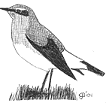|
Back to
Newsletter
Systematic list -
Mediterranean Gull to Great Black-backed Gull.
Kittiwake to Rock
Pigeon.
Stock Pigeon to Sand
Martin.
Swallow to Wren.
Hedge Accentor to Blackbird (below).
Fieldfare to Garden
Warbler.
Blackcap to Coal Tit.
Blue Tit to Chaffinch.
Greenfinch to Reed
Bunting.
Hedge Accentor
Prunella modularis
Resident
Present throughout. Recently fledged birds were noted from May 2nd.
[ See Winter Wren. ]
European Robin
Erithacus rubecula
Resident
Present throughout. 3 recently fledged young on April 28th. were the only sign of local breeding. There was an influx into the general area on September 29th. when a minimum of 25 were present on site.
[ See Winter Wren. ]
Black Redstart
Phoenicurus ochruros
County rarity
1 female October 12th. at Red Rocks ( CB )
[ A typical, if very slightly early, date for this enigmatic bird whose position in the county fluctuates between rare breeder to passage migrant to non-existence in some years. Most records from the site are from the end of October but birds can turn up in spring. Awaiting confirmation by CAWOS Rarities Committee.]
Common Redstart
P. phoenicurus
Passage migrant
1 May 2nd, 1 May 13th, 1 May 17th, 1 September 3rd. at Red Rocks.
[ Although this was a better year than last, when none were recorded, it is still rather poor. Redstart are one of the three 'classic' birds of western oakwoods, along with Pied Flycatcher and Wood Warbler, and as such should be encountered far more frequently on passage than the records show. ]
Whin Chat
Saxicola rubetra
Passage migrant
1 April 30th., 1 May 5th, 2 May 6th. and 12th., 4 September 6th., 1 ( juv. ) September 29th. were the only records for the year. All were in the dunes at Red Rocks.
[Other areas close by recorded far more birds than we did on site. At the risk of sounding repetitious, the amount of disturbance during spring migration by itinerant dog walkers was probably to blame.]
Common Stonechat
S. torquata
Fluctuates between rare resident and scarce passage
3 ( 2. m., 1 f. ) were present from last year and were joined by a second female on March 9th and remained throughout most of the year. The only passage bird noted was a male on March 21st. At the end of the year there was only a single male present.
[The first winter male from last year set up territory with the second female at the West Kirby end of the golfcourse. Both pairs were noted throughout the summer and were extremely secretive, but became much more visible from the middle of September. It is not known if either pair bred this year as no juveniles were seen.]
Northern Wheatear
Oenanthe oenanthe
Passage migrant
First recorded :- 2 March 23rd.
Peak count spring passage :- 19 March 28th.
First returning birds :- 2 ( juv. ) July 24th
Peak count autumn passage :- 11 September 6th.
Last recorded :- 1 November 17th.
|
 |
[ A very poor spring with extremely low numbers overall and autumn was not much better. There was a slight upturn in birds on the shore at the end of April and beginning of May which coincided with the peak of the next taxon. First and last dates in 2000 were March 19th. and October 21st.]
Greenland Wheatear
Oe. oe. leucorrhoa
Passage migrant
First recorded :- 2 ( m. )April 30th.
Peak :- 11 ( 2m., 9f. ) May 9th.
The only definite records of autumn birds this year were of 2 October 2nd and 1 October 18th.
[ This large, bright, plump Wheatear is normally one of the highlights of spring and, unlike other passerines this year, there was a very good passage during the first migration period with c. 45 birds passing through overall. The reason is probably because Wheatear tend to move onto the shore from the golfcourse in mid-morning, after the majority of dog walkers have left. ]
Ring Ouzel
Turdus torquatus
Rare passage migrant
1 ( m. ) May April 10th., 2 September 12th. at Red Rocks.
[ Even allowing for the decline in numbers and for range contraction there seems to be no reason for Ring Ouzel to be as scarce as they are, either on site, or on Hilbre. With populations to the north, east and south of us they should show up more frequently on passage.]
Common Blackbird
T. merula
Resident
Present throughout. A minimum of 60 birds were present around the site on October 16th. and a flock of 27 were in the Poplars on 19th. along with Fieldfare and Redwing indicating autumn passage.
[See Winter Wren.]
Fieldfare to
Garden Warbler.
|
